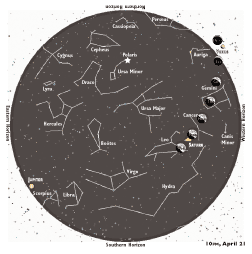Wish Upon a Shooting Star
With an early-setting moon, all we have to hope for is clear skies
The waxing moon returns to our evening skies this week. Look for Luna hovering low in the east after sunset, at 7:48, the 19th between Venus and the Pleiades star cluster at near Taurus the bull. By the next night, the moon has left Venus and is near the bull’s northern horn.
Saturday evening, the Moon shines midway between four bright lights. To the east and west are Saturn and Venus; to the north and south are Capella of Auriga the charioteer and the Little Dipper’s Procyon.
The Lyrid meteor shower peaks after midnight and before dawn on Sunday, April 22, when between 10 and 15 meteors per hour should dazzle skywatchers. The Lyrids are one of the oldest known meteor showers, first recorded by Chinese scholars in 687bc. Named after the constellation Lyra the harp, from which the meteors appear to emanate, the show will likely begin after midnight, when the constellation is well overhead and after the crescent moon has set.
The Lyrids are caused each year as earth passes through a trail of cosmic dust and debris left in the wake of comet Thatcher. As these tiny bits collide with our atmosphere, they burst into flames and streak across our sky. While the Lyrids are not as remarkable as some meteor showers, such as the Perseids and the Leonids, which from time to time storm with hundreds of meteors each hour, they are incredibly reliable, offering ample shooting stars both a week before and after peak.
Tidelog®
Illustration: © Copyright 1925 M.C. Escher/Cordon Art-Baarn-Holland; Graphics: © Copyright 2007 Pacific Publishers. Reprinted by permission from the Tidelog graphic almanac. Bound copies of the annual Tidelog for Chesapeake Bay are $14.95 ppd. from Pacific Publishers, Box 480, Bolinas, CA 94924. Phone 415-868-2909. Weather affects tides. This information is believed to be reliable but no guarantee of accuracy is made by Bay Weekly or Pacific Publishers. The actual layout of Tidelog differs from that used in Bay Weekly. Tidelog graphics are repositioned to reflect Bay Weekly’s distribution cycle.Tides are based on National Oceanic and Atmospheric Administration and are positioned to coincide with high and low tides of Tidelog.
